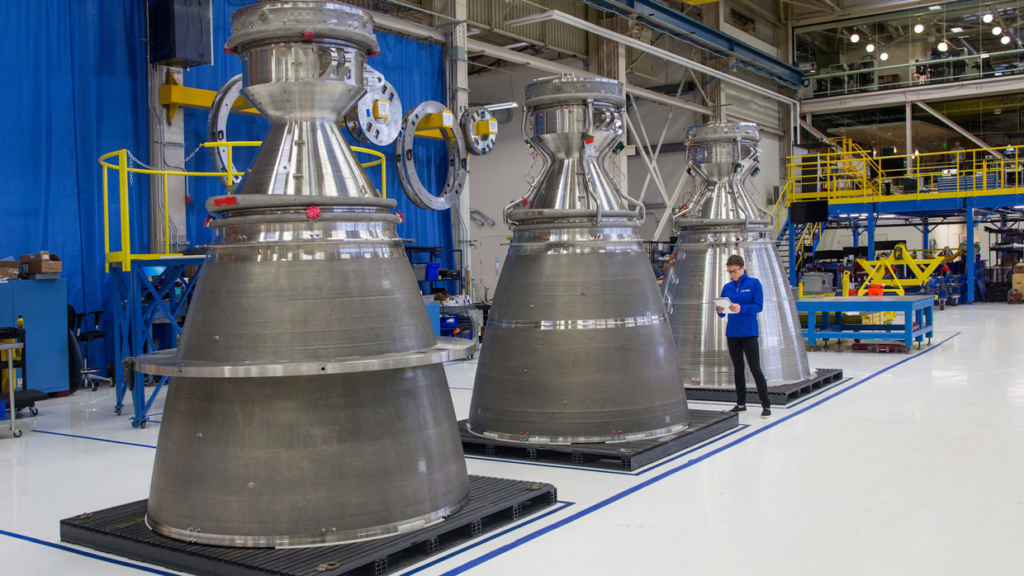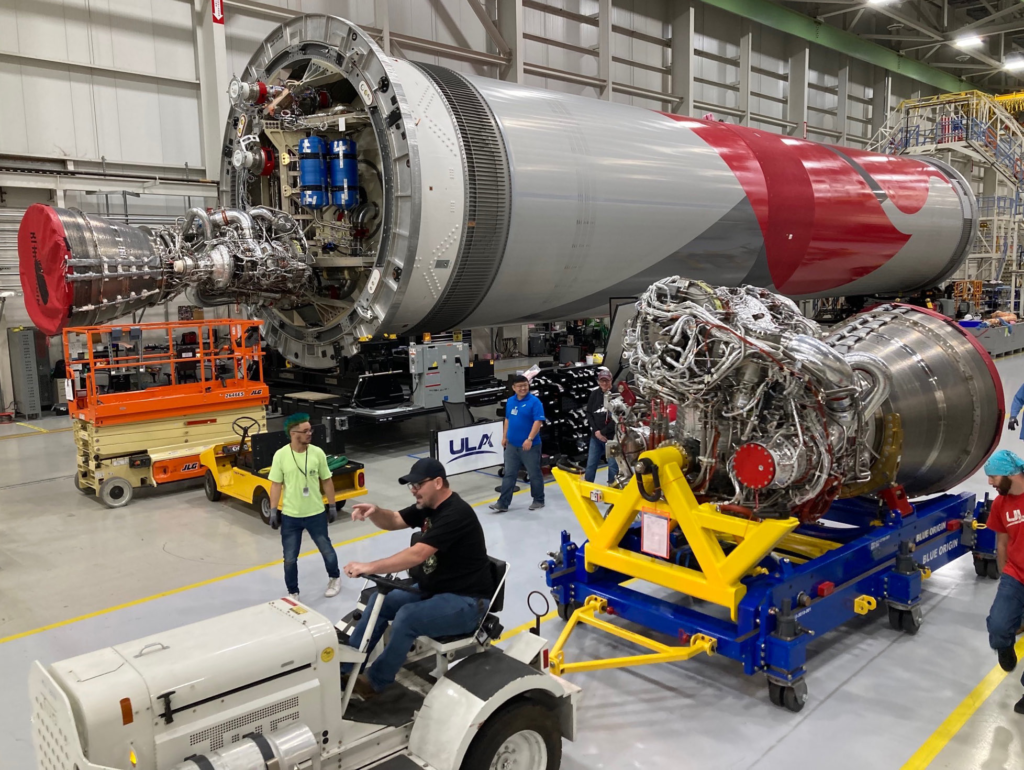
Can Blue Origin Keep Up With The BE-4 Engine Demand?
For years now Blue Origin has been developing, manufacturing, and testing the BE-4 engine. While there have been some significant delays over time, they are starting to deliver engines and prepare for a busy future. With Vulcan’s launch cadence expected to increase drastically after the first launch and New Glenn getting closer to testing, the demand for these engines will follow suit.
Just days ago Blue Origin released a rare sneak peek inside one of the company’s factories which reveals work on over a dozen engines. This being said, it brings up the question of how will these engines perform on Vulcan’s first launch and can the company keep up with the future needs of ULA and Blue Origin.
While each Vulcan rocket only needs two engines, it’s not reusable so every rocket will require more. As for New Glenn, just a single launch vehicle requires 7. All of which combine to create an engine program that needs to go from 0 to 100 in terms of production to keep up. Here I will go more in-depth into Blue Origin’s BE-4 production, the substantial demand right around the corner, what to expect in the coming months, and more.
BE-4 Production

Blue Origin rarely shares information which is a downside but recently they did show us some of what they’re working on. Only 5 days ago on the 19th Blue Origin tweeted saying “The regen nozzle room in our Huntsville engines factory.” This included a video showing off 10s of BE-4 engines in early production. Interestingly, around two years prior the company posted a video in the same factory however, it was very barren in comparison with small amounts of equipment and engines in production. In the past Blue Origin had commented that they were beginning to increase production but this is the first we’ve seen. Specifically, back in October of last year, the company was quoted saying, “Dozens of these engines are now in production to support a large and growing demand for civil, commercial, and defense launches.
This demand comes as New Glenn and especially Vulcan prepare for a busy future. To put in perspective the amount of Vulcan launches expected, ULA CEO Tory Bruno commented, “We have to ramp up, before the end of 2025 we expect to be really at a tempo, which is flying a couple of times a month, every two weeks.” This amount of engines is a very big deal as it comes out to around 48 BE-4 engines a year. It’s also important to point out that United Launch Alliance has priority when it comes to receiving these engines. This means that Blue Origin will need to make enough engines for Vulcan and ULA first and then additional for each New Glenn booster.
As partially mentioned before, a lot of this demand has to do with the fact that Vulcan is not reusable and each launch will use up two BE-4 engines. While the company does have some plans for Vulcan partial reusability, it might be a while. In another quote, Tory Bruno said, “In terms of our engine recovery, that is going to happen within a handful of years. I don’t want to say exactly when because it’s part of the contract we have with one of our customers at this time, and we’re not releasing the details of that. But it will take a couple of years to actually be reusing the engine.” He finished by saying, “You will see us potentially do more demonstrations. We’ll be collecting environmental data to see booster experiences. We’ll recover engines and look at them. And then eventually we’ll have the confidence to recover them, inspect them, and then reuse them. And so that will happen in this window of a few years, but it’s too early at this moment for me to say exactly when. But you’ll see that activity ramp up.”
In other words, the reusability of Vulcan and the two BE-4 engines is not a priority right now for ULA. This means that as Vulcan launch cadence increases, the demand for BE-4 engines will grow as well. As for New Glenn, a realistic initial launch date would be around late 2025. In preparing for this, the company will need to complete a host of tests with different components such as the engines. However, around this exact time period is when Vulcan launches are supposed to be at an all-time high. Based on the recent video, it looks as if Blue Origin is making good progress and trying to get ahead of the demand.
A Busy Future

In addition to work on BE-4 production, the engine’s most important test yet could be right around the corner. ULA’s Vulcan is at the pad with two BE-4 engines installed and performing final tests. Unfortunately, this launch is behind quite a bit. Late last year the rocket was expected to arrive at the launch site in November and complete testing in December. In reality, it arrived early this year and still needs to complete a few tests. After the initial delays, ULA was targeting May 4th as the start of a four day launch window. Based on current progress and the date just over a week away, this launch will likely get pushed back. The next step in the countdown to the inaugural launch includes conducting a Wet Dress Rehearsal (WDR) to practice the day-of-launch activities and then performing a Flight Readiness Firing (FRF) to complete the full Terminal Countdown sequence, ignite the engines and demonstrate a hot-fire abort recycle and saving.
This comes in addition to the recent explosion of a separate Vulcan upper stage. While not ideal, it’s said that it won’t affect the first launch of Vulcan. Either way, when Vulcan does lift off, it will be a very big moment for this engine. If the test goes perfectly then we can expect Blue Origin to continue to ramp up production. However, if the test experiences an anomaly related to the BE-4 engines, it would cause big delays for Blue Origin as they figure out exactly what happened and how to make sure it doesn’t happen again.
At the end of the day, next generation engine production is by no means easy. The BE-4 was designed from the beginning to be a medium-performing version of a high-performance architecture. A conscious design choice made to lower development risk while trying to meet performance, schedule and reusability requirements. Blue Origin points out that its hardware-rich approach, multiple developmental units, and redundant test stands enable a high test tempo and rapid learning. They chose LNG as the propellant because its highly efficient, low cost, and widely available. Unlike kerosene, LNG can be used to self-pressurize its tank. Known as autogenous repressurization, this eliminates the need for costly and complex systems that draw on Earth’s helium reserves. LNG also possesses clean combustion characteristics even at low throttle, simplifying engine reuse compared to kerosene fuels.
Late last year, Blue Origin completed its delivery of the first BE-4 shipset for United Launch Alliance (ULA), shipping the engines to ULA’s factory in Decatur, AL after final acceptance testing. Each BE-4 engine provides 550,000 pounds of thrust and has completed an extensive development program. This engine is intended to end reliance on Russian engines and power a new generation of U.S. launch vehicles. At the time CEO of Blue Origin, Bob Smith said, “We’re excited to see ULA’s Vulcan fly. The BE-4 is a great engine, and we’re proud of Team Blue for achieving this milestone as part of ULA’s team. It’s been a wonderful partnership, and this shipset is the first of many more to come.”
Tory Bruno also commented, “We are very pleased to receive the first two engines for Vulcan’s inaugural flight. Development of this new engine is complete, and the performance of the engine is outstanding. It has been a great team effort working together with our partners at Blue Origin and we can’t wait to see Vulcan fly.” With these quotes in mind, it’s clear that Blue Origin has a lot of responsibility for the future of the Vulcan launch program and how many engines they can deliver.
The reusability method ULA has been considering is called SMART Reuse. This process involves the separation of the engines and the bottom portion of the rocket. After separation, the nose assembly extends to position the Hypersonic Inflatable Aerodynamic Decelerator (HIAD) such that it will clear the separation plane when inflated. Preliminary results indicate a 10- 12 meter HIAD will be required to recover the booster module. From here, it would continue through Earth’s atmosphere before parachute deployment. This would slow down the two BE-4s and additional technology significantly before a planned soft water landing. Here they would float on an inflatable aeroshell before being recovered by ULA and taken back to land for refurbishment. Recently on the 17th Troy tweeted mentioning, “UFO” was a good guess, but this is actually the revolutionary LOFTID inflatable hypersonic heat shield demo.” These tests are core to the future of Vulacn reuse and recovering the engine section with the two BE-4 engines.
Conclusion
Blue Origin has begun ramping up BE-4 engine production significantly as more and more engines are expected to be needed in the coming years. With Vulcan hoping to launch multiple times a month and New Glenn testing around the corner, these engines will be in very high demand. The recent update from the company highlights that they are serious about delivering these engines on time. We will have to wait and see how it progresses and the impact it has on the space industry.
